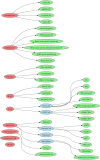HIDE: hierarchical cell-type deconvolution
- PMID: 40662776
- PMCID: PMC12261400
- DOI: 10.1093/bioinformatics/btaf179
HIDE: hierarchical cell-type deconvolution
Abstract
Motivation: Cell-type deconvolution is a computational approach to infer cellular distributions from bulk transcriptomics data. Several methods have been proposed, each with its own advantages and disadvantages. Reference based approaches make use of archetypic transcriptomic profiles representing individual cell types. Those reference profiles are ideally chosen such that the observed bulks can be reconstructed as a linear combination thereof. This strategy, however, ignores the fact that cellular populations arise through the process of cellular differentiation, which entails the gradual emergence of cell groups with diverse morphological and functional characteristics.
Results: Here, we propose Hierarchical cell-type Deconvolution (HIDE), a cell-type deconvolution approach which incorporates a cell hierarchy for improved performance and interpretability. This is achieved by a hierarchical procedure that preserves estimates of major cell populations while inferring their respective subpopulations. We show in simulation studies that this procedure produces more reliable and more consistent results than other state-of-the-art approaches. Finally, we provide an example application of HIDE to explore breast cancer specimens from TCGA.
Availability and implementation: A python implementation of HIDE is available at zenodo (doi: 10.5281/zenodo.14724906).
© The Author(s) 2025. Published by Oxford University Press.
Figures
References
MeSH terms
Grants and funding
LinkOut - more resources
Full Text Sources


